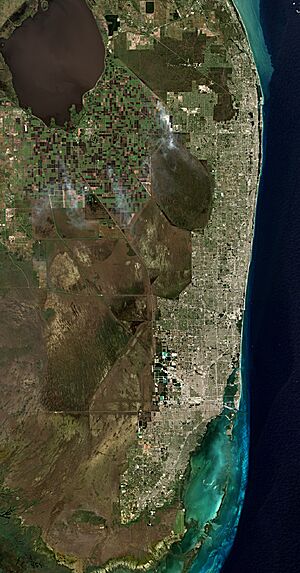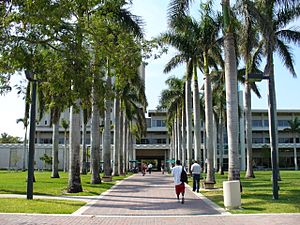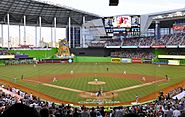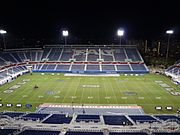Miami metropolitan area facts for kids
Quick facts for kids
Miami metropolitan area
Miami–Fort Lauderdale–West Palm Beach, FL Metropolitan Statistical Area
|
|
|---|---|
|
Metropolitan area, Megacity and combined statistical area
|
|

From top (left to right): Greater Downtown Miami, Fort Lauderdale, Sawgrass Mills, The Square at West Palm Beach, Miami Beach, and Boca Raton
|
|
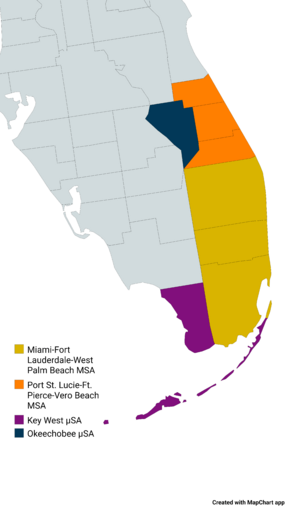
Location of the Miami metropolitan area's four primary components in Florida
|
|
| Country | |
| State | |
| Core city | |
| Principal cities | |
| Area | |
| • Land | 6,137 sq mi (15,890 km2) |
| Highest elevation | Jupiter 53 ft (16.2 m) |
| Lowest elevation | Atlantic Ocean 0 ft (0 m) |
| Population
(2020)
|
|
| • Total | 6,138,333 |
| • Estimate
(2023)
|
6,183,199 |
| • Rank | 9th in the United States 1st in Florida |
| • Density | 1,000.38/sq mi (386.37/km2) |
| GDP | |
| • MSA | $483.755 billion (2022) |
| Time zone | UTC−05:00 (Eastern Standard Time) |
| • Summer (DST) | UTC−04:00 (Eastern Daylight Time) |
The Miami metropolitan area is a coastal metropolitan area in southeastern Florida. It is the ninth-largest metropolitan statistical area (MSA) in the United States, the fifth-largest metropolitan area in the Southern United States, and the largest metropolitan area in Florida. It is also known as South Florida, SoFlo, SoFla, the Gold Coast, Southeast Florida, the Tri-County Area, or Greater Miami, and officially as the Miami–Fort Lauderdale–West Palm Beach Metropolitan Statistical Area. With a population of 6.18 million, its population exceeds 31 of the nation's 50 states as of 2023. It comprises the three most populated counties in the state, Miami-Dade County, Broward County, and Palm Beach County, which rank as the first, second, and third-most populous counties in the state, respectively. Miami-Dade County, with 2,701,767 people in 2020, is the seventh-most populous county in the United States.
Miami is the region's financial and cultural core and most populous city. Other principal cities, as defined by the Office of Management and Budget, include Fort Lauderdale, West Palm Beach, Pompano Beach, Boca Raton, Sunrise, Deerfield Beach, Miami Beach, Kendall, Doral, Delray Beach, Jupiter, and Palm Beach Gardens. The Miami metropolitan area is part of the larger South Florida region of the state, which also includes the Everglades and the Florida Keys.
With 1,279.2 sq mi (3,313 km2) of urban landmass, the Miami metropolitan area also is one of the world's most populous urban agglomerations.
South Florida is largely confined to a strip of land between the Atlantic Ocean and Everglades, and Miami's urbanized area is about 100 miles (160 km) long (north to south) and at most 20 miles (32 km) east to west; in some areas, its east to west width is only 5 miles (8 km). The Miami metropolitan statistical area is the second-longest urbanized area in the United States behind the New York metropolitan area. It was the eighth-most densely populated urbanized area in the United States as of the 2000 census.
As of the 2020 census, the Miami-Fort Lauderdale urbanized area had a land area of 1,244.18 square miles (3,222.4 km2), with a population of 6,077,522, for a population density of 4,884.78 inhabitants per square mile (1,886.02/km2). The Miami metropolitan area also had one urban cluster (UC) as of the 2020 census, which is not part of the Miami urbanized area. The Belle Glade urban cluster had a population of 23,009, area of 7.21 square miles (18.7 km2) and population density of 3,191.41 inhabitants per square mile (1,232.21/km2). Miami, the largest city in the metropolitan area, had population density of over 10,000/sq mi (more than 3,800/km2) in 2000. The Miami Urbanized Area was the fourth-largest urbanized area in the United States in the 2010 census.
The most notable colleges and universities in the Miami metropolitan area include Florida Atlantic University, Florida International University, Nova Southeastern University, and the University of Miami. The region also has three community colleges, Broward College, Miami Dade College, and Palm Beach State College. Some of these institutions, such as Florida International University and Miami Dade College, make up some of the largest institutions of higher learning in the United States.
Contents
Other names
The Miami metropolitan area is also known as South Florida, SoFlo, SoFla, the Gold Coast, the Tri-County Area, or Greater Miami, and, for U.S. government statistical purposes, the Miami–Fort Lauderdale–West Palm Beach Metropolitan Statistical Area.
Definitions
Miami metropolitan area
As of 2023[update], the Miami metropolitan area is defined by the U.S. Office of Management and Budget as the Miami-Fort Lauderdale-West Palm Beach Metropolitan Statistical Area (MSA), with a 2020 population of 6,138,333. The MSA is made up of three "metropolitan divisions" :
- Miami-Miami Beach-Kendall Metropolitan Division, coterminous with Miami Dade County (2020 population 2,701,767).
- Fort Lauderdale-Pompano Beach-Sunrise Metropolitan Division, coterminous with Broward County (2020 population 1,944,375).
- West Palm Beach-Boca Raton-Delray Beach Metropolitan Division, coterminous with Palm Beach County (2020 population 1,492,191).
The MSA is the second most populous metropolitan area in the Southeastern United States and has an area of 6,137 sq. mi (15,890 km2).
The original MSA for Miami, as defined by the OMB, included only Dade County (now Miami-Dade County). By 1995, the Miami-Hialeah and Fort Lauderdale-Hollywood-Pompano Beach MSAs had been merged into the Miami-Fort Lauderdale Consolidated MSA, consisting of the Miami Primary MSA (Dade County) and the Fort Lauderdale Primary MSA (Broward County). In 2003, the West Palm Beach-Boca Raton-Boynton Beach MSA was merged with the consolidated MSA to form the Miami-Fort Lauderdale-Miami Beach Metropolitan Statistical Area, consisting of: the Fort Lauderdale-Pompano Beach-Deefield Beach Metropolitan Division (Broward County), the Miami-Miami Beach-Kendall Metropolitan Division (Miami-Dade County), and the West Palm Beach-Boca Raton-Boynton Beach Metropolitan Division (Palm Beach County).
Miami-Port Saint Lucie-Fort Lauderdale Combined Statistical Area
The Census Bureau also defines a wider commercial region based on commuting patterns, the Miami-Port Saint Lucie-Fort Lauderdale Combined Statistical Area (CSA), with a population of 6,887,655 in 2020.
As of 2023[update], the CSA consists of three component metropolitan statistical areas (MSAs) and one Micropolitan statistical area (μSA):
- The Miami-Fort Lauderdale-West Palm Beach MSA (2020 pop. 6,138,333)
- The Port Saint Lucie MSA (2020 pop. 486,660), consisting of:
- Martin County (2020 pop. 158,431)p. 28
- Saint Lucie County (2020 pop. 329,226)p. 28
- The Sebastian-Vero Beach-West Vero Corridor MSA, coterminous with Indian River County (2020 pop. 159,788)
- The Key West-Key Largo μSA, coterminous with Monroe County (2020 pop. 82,874).
- The Okeechobee μSA, coterminous with Okeechobee County.
When the CSA was defined in 2013, it included the Okeechobee μSA, but not the Key West μSA. In 2018 the Okeechobee μSA was removed from the CSA and the Key West μSA was added. The Okeechobee μSA was re-added to the CSA in 2023.
Gold Coast
The Miami metropolitan area is frequently named the "Gold Coast" in convention with Florida's other coast regions, including the Space Coast, Treasure Coast, Sun Coast, Nature Coast, Forgotten Coast, Emerald Coast, Fun Coast, and First Coast. Like several of the others, it seems to have originated at the time the area first saw major growth. One of the best known of Florida's vernacular regions, the name is a reference to the wealth and ritzy tropical lifestyle that characterizes the area.
Climate and geography
Climate
South Florida/Miami metropolitan area has a tropical climate, similar to the climate found in much of the Caribbean. It is the only metropolitan area in the 48 contiguous states that falls under that category. More specifically, it generally has a tropical monsoon climate (Köppen climate classification, Am). The South Florida metropolis sees most of its rain in the summer (wet season) and is quite dry in the winter (dry season). The wet season, which is hot and humid, lasts from May to October, when daily thunderstorms and passing weak tropical lows bring downpours during the late afternoon. The dry season often starts in late October and runs through late April. During the height of the dry season from February through April, South Florida is often very dry, and often brush fires and water restrictions are an issue. At times cold fronts can make it all the way down to South Florida and provide some modest rainfall in the dry season. The hurricane season largely coincides with the wet season.
In addition to its sea-level elevation, coastal location and position near the Tropic of Cancer and the Caribbean, the area owes its warm, humid climate to the Gulf Stream, which moderates climate year-round. A typical summer day does not see temperatures below 75 °F (24 °C). Temperatures in the high 80s to low 90s (30–35 °C) accompanied by high humidity are often relieved by afternoon thunderstorms or a sea breeze that develops off the Atlantic Ocean, which then allow lower temperatures, although conditions still remain very muggy.
During winter, dry air often dominates as dew points are often very low. Average daily high temperatures across South Florida during the winter are around 74–77 °F (23–25 °C). Although daily highs can sometimes reach 82–85 °F (28–29 °C) even in January and February. Daily low temperatures during the winter are generally around 55–63 °F (13–17 °C). Each winter, cold fronts occasionally make their way down to the northern Bahamas and South Florida. As a result, daytime high temperatures in South Florida may only reach around 65 °F (18 °C) or cooler. When this occurs low temperatures can dip into the 40s during the early morning hours before quickly warming-up toward late morning/early afternoon. It is rare for temperatures to drop below 40 °F (4 °C), however, low temperatures at or around 35 °F (2 °C) have occurred some years. South Florida only experiences these cold spells about twice each winter and they typically only last a day or two before temperatures return to the mid 70s. On average South Florida is frost-free, although there can be a light frost in the inland communities about once every decade.
Hurricane season officially runs from June 1 through November 30, although hurricanes can develop outside that period. The most likely time for South Florida to be hit is during the peak of the Cape Verde season, mid-August through the end of September. Due to its location between two major bodies of water known for tropical activity, South Florida is also statistically the most likely major area to be struck by a hurricane in the world, trailed closely by Nassau, Bahamas, and Havana, Cuba. Many hurricanes have affected the metropolis, including Betsy in 1965, Andrew in 1992, Irene in 1999, Hurricanes Katrina and Wilma in 2005, and Irma in 2017. In addition, a tropical depression in October 2000 passed over the city, causing record rainfall and flooding. Locally, the storm is credited as the No Name Storm of 2000, though the depression went on to become Tropical Storm Leslie upon entering the Atlantic Ocean.
| Climate data for West Palm Beach Airport, Florida (1981–2010 normals, extremes 1888–present) | |||||||||||||
|---|---|---|---|---|---|---|---|---|---|---|---|---|---|
| Month | Jan | Feb | Mar | Apr | May | Jun | Jul | Aug | Sep | Oct | Nov | Dec | Year |
| Mean daily maximum °F (°C) | 75.2 (24.0) |
76.3 (24.6) |
80.0 (26.7) |
84.1 (28.9) |
87.0 (30.6) |
90.7 (32.6) |
92.0 (33.3) |
91.3 (32.9) |
88.3 (31.3) |
84.3 (29.1) |
82.3 (27.9) |
76.7 (24.8) |
84.3 (29.1) |
| Mean daily minimum °F (°C) | 57.4 (14.1) |
58.6 (14.8) |
61.7 (16.5) |
65.0 (18.3) |
71.1 (21.7) |
75.0 (23.9) |
75.2 (24.0) |
75.4 (24.1) |
74.3 (23.5) |
70.9 (21.6) |
63.4 (17.4) |
60.0 (15.6) |
66.8 (19.3) |
| Average rainfall inches (mm) | 2.18 (55) |
2.09 (53) |
2.05 (52) |
2.03 (52) |
5.76 (146) |
9.02 (229) |
9.27 (235) |
9.83 (250) |
9.93 (252) |
9.57 (243) |
5.07 (129) |
2.27 (58) |
60.35 (1,533) |
| Average rainy days (≥ 0.01 in) | 7.8 | 6.7 | 5.0 | 5.8 | 14.1 | 16.0 | 18.1 | 19.0 | 16.7 | 17.1 | 10.2 | 7.1 | 132.6 |
| Source: NOAA | |||||||||||||
| Climate data for Fort Lauderdale Int'l Airport, Florida (1981–2010 normals, extremes 1912–present) | |||||||||||||
|---|---|---|---|---|---|---|---|---|---|---|---|---|---|
| Month | Jan | Feb | Mar | Apr | May | Jun | Jul | Aug | Sep | Oct | Nov | Dec | Year |
| Mean daily maximum °F (°C) | 75.5 (24.2) |
76.7 (24.8) |
78.5 (25.8) |
82.9 (28.3) |
85.6 (29.8) |
89.8 (32.1) |
91.9 (33.3) |
90.5 (32.5) |
88.8 (31.6) |
85.8 (29.9) |
81.0 (27.2) |
76.9 (24.9) |
83.3 (28.5) |
| Mean daily minimum °F (°C) | 59.0 (15.0) |
60.5 (15.8) |
63.4 (17.4) |
66.9 (19.4) |
72.0 (22.2) |
74.4 (23.6) |
75.9 (24.4) |
75.8 (24.3) |
75.2 (24.0) |
71.8 (22.1) |
65.7 (18.7) |
61.3 (16.3) |
67.7 (19.8) |
| Average rainfall inches (mm) | 3.63 (92) |
2.96 (75) |
3.36 (85) |
2.89 (73) |
4.65 (118) |
10.16 (258) |
5.98 (152) |
7.44 (189) |
8.59 (218) |
6.82 (173) |
3.24 (82) |
2.46 (62) |
62.18 (1,579) |
| Average rainy days (≥ 0.01 in) | 5.0 | 6.1 | 6.9 | 5.4 | 8.8 | 15.9 | 15.9 | 15.7 | 15.8 | 10.6 | 8.1 | 8.1 | 122.3 |
| Climate data for Miami (MIA), 1981−2010 normals, extremes 1895−present | |||||||||||||
|---|---|---|---|---|---|---|---|---|---|---|---|---|---|
| Month | Jan | Feb | Mar | Apr | May | Jun | Jul | Aug | Sep | Oct | Nov | Dec | Year |
| Record high °F (°C) | 88 (31) |
89 (32) |
93 (34) |
96 (36) |
96 (36) |
98 (37) |
100 (38) |
98 (37) |
97 (36) |
95 (35) |
91 (33) |
89 (32) |
100 (38) |
| Mean maximum °F (°C) | 84.3 (29.1) |
85.5 (29.7) |
87.9 (31.1) |
90.2 (32.3) |
92.3 (33.5) |
94.0 (34.4) |
94.6 (34.8) |
95.0 (35.0) |
93.1 (33.9) |
90.7 (32.6) |
86.9 (30.5) |
84.8 (29.3) |
96.1 (35.6) |
| Mean daily maximum °F (°C) | 76.4 (24.7) |
78.1 (25.6) |
80.3 (26.8) |
83.2 (28.4) |
87.0 (30.6) |
89.5 (31.9) |
90.9 (32.7) |
91.0 (32.8) |
89.3 (31.8) |
86.2 (30.1) |
81.7 (27.6) |
77.9 (25.5) |
84.3 (29.1) |
| Daily mean °F (°C) | 68.2 (20.1) |
70.2 (21.2) |
72.6 (22.6) |
75.8 (24.3) |
79.9 (26.6) |
82.7 (28.2) |
84.1 (28.9) |
84.2 (29.0) |
82.9 (28.3) |
79.9 (26.6) |
74.9 (23.8) |
70.5 (21.4) |
77.2 (25.1) |
| Mean daily minimum °F (°C) | 59.9 (15.5) |
62.3 (16.8) |
64.9 (18.3) |
68.3 (20.2) |
72.9 (22.7) |
76.0 (24.4) |
77.3 (25.2) |
77.4 (25.2) |
76.5 (24.7) |
73.5 (23.1) |
68.1 (20.1) |
63.0 (17.2) |
70.0 (21.1) |
| Mean minimum °F (°C) | 43.1 (6.2) |
46.6 (8.1) |
50.6 (10.3) |
57.3 (14.1) |
65.3 (18.5) |
70.7 (21.5) |
72.3 (22.4) |
72.3 (22.4) |
72.1 (22.3) |
63.8 (17.7) |
54.9 (12.7) |
46.3 (7.9) |
40.1 (4.5) |
| Record low °F (°C) | 28 (−2) |
27 (−3) |
32 (0) |
39 (4) |
50 (10) |
60 (16) |
66 (19) |
67 (19) |
62 (17) |
45 (7) |
36 (2) |
30 (−1) |
27 (−3) |
| Average rainfall inches (mm) | 1.62 (41) |
2.25 (57) |
3.00 (76) |
3.14 (80) |
5.34 (136) |
9.67 (246) |
6.50 (165) |
8.88 (226) |
9.86 (250) |
6.33 (161) |
3.27 (83) |
2.04 (52) |
61.90 (1,572) |
| Average rainy days (≥ 0.01 in) | 6.9 | 6.5 | 7.0 | 6.4 | 10.0 | 16.4 | 16.9 | 18.9 | 17.9 | 12.7 | 8.4 | 7.2 | 135.2 |
| Average relative humidity (%) | 72.7 | 70.9 | 69.5 | 67.3 | 71.6 | 76.2 | 74.8 | 76.2 | 77.8 | 74.9 | 73.8 | 72.5 | 73.2 |
| Mean monthly sunshine hours | 219.8 | 216.9 | 277.2 | 293.8 | 301.3 | 288.7 | 308.7 | 288.3 | 262.2 | 260.2 | 220.8 | 216.1 | 3,154 |
| Percent possible sunshine | 66 | 69 | 75 | 77 | 72 | 70 | 73 | 71 | 71 | 73 | 68 | 66 | 71 |
| Source: NOAA (relative humidity and sun 1961–1990), The Weather Channel | |||||||||||||
| Climate data for Miami Beach, 1981−2010 normals | |||||||||||||
|---|---|---|---|---|---|---|---|---|---|---|---|---|---|
| Month | Jan | Feb | Mar | Apr | May | Jun | Jul | Aug | Sep | Oct | Nov | Dec | Year |
| Mean daily maximum °F (°C) | 73.8 (23.2) |
74.9 (23.8) |
76.3 (24.6) |
79.4 (26.3) |
82.8 (28.2) |
86.5 (30.3) |
88.1 (31.2) |
88.5 (31.4) |
87.0 (30.6) |
83.7 (28.7) |
79.3 (26.3) |
75.7 (24.3) |
81.3 (27.4) |
| Mean daily minimum °F (°C) | 61.4 (16.3) |
63.0 (17.2) |
65.3 (18.5) |
69.2 (20.7) |
73.9 (23.3) |
77.0 (25.0) |
78.3 (25.7) |
78.6 (25.9) |
77.7 (25.4) |
74.7 (23.7) |
69.5 (20.8) |
64.3 (17.9) |
71.1 (21.7) |
| Average rainfall inches (mm) | 2.09 (53) |
2.33 (59) |
3.00 (76) |
3.20 (81) |
4.98 (126) |
8.27 (210) |
4.35 (110) |
6.37 (162) |
7.88 (200) |
4.47 (114) |
2.74 (70) |
2.05 (52) |
51.73 (1,313) |
| Average rainy days (≥ 0.01 in) | 6.7 | 6.0 | 6.9 | 6.0 | 8.9 | 14.5 | 12.1 | 14.0 | 14.9 | 11.2 | 8.1 | 6.9 | 116.2 |
| Source: NOAA (extremes 1927−present) | |||||||||||||
Component counties, subregions, and cities
Largest cities

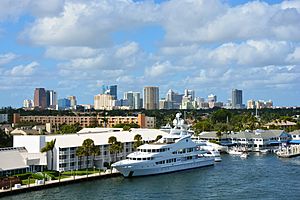

The following is a list of the twenty largest cities in the Miami metropolitan area as ranked by population.
| City | County | 2000 population |
2010 population |
2020 population |
2010 to 2020 % change |
|---|---|---|---|---|---|
| Miami | Miami-Dade | 362,470 | 399,457 | 442,241 | +10.71% |
| Hialeah | Miami-Dade | 226,419 | 224,669 | 223,109 | −0.69% |
| Fort Lauderdale | Broward | 152,397 | 165,521 | 182,760 | +10.41% |
| Pembroke Pines | Broward | 137,427 | 154,750 | 171,178 | +10.62% |
| Hollywood | Broward | 139,357 | 140,768 | 153,067 | +8.74% |
| Miramar | Broward | 72,739 | 122,041 | 134,721 | +10.39% |
| Coral Springs | Broward | 117,549 | 121,096 | 133,394 | +10.16% |
| Miami Gardens | Miami-Dade | 100,758 | 107,167 | 111,640 | +4.17% |
| Pompano Beach | Broward | 78,191 | 99,845 | 112,046 | +12.22% |
| West Palm Beach | Palm Beach | 82,103 | 99,919 | 117,415 | +17.51% |
| Davie | Broward | 75,720 | 91,922 | 105,691 | +14.98% |
| Boca Raton | Palm Beach | 74,764 | 84,392 | 97,422 | +15.44% |
| Sunrise | Broward | 85,779 | 84,439 | 97,335 | +15.27% |
| Plantation | Broward | 82,934 | 84,955 | 91,750 | +8.00% |
| Miami Beach | Miami-Dade | 87,933 | 87,779 | 82,890 | −5.57% |
| Deerfield Beach | Broward | 64,583 | 75,018 | 86,859 | +15.78% |
| Boynton Beach | Palm Beach | 60,389 | 68,217 | 80,380 | +17.83% |
| Lauderhill | Broward | 57,585 | 66,887 | 74,482 | +11.35% |
| Doral | Miami-Dade | 20,438 | 45,704 | 75,874 | +66.01% |
| Homestead | Miami-Dade | 31,909 | 60,512 | 80,737 | +33.42% |
Areas with between 10,000 and 100,000 inhabitants
- Aventura
- Belle Glade
- Boca Del Mar
- Boynton Beach
- Brownsville
- Coconut Creek
- Cooper City
- Coral Gables
- Coral Terrace
- Country Club
- Country Walk
- Cutler Bay
- Dania Beach
- Deerfield Beach
- Delray Beach
- Doral
- Florida City
- Fontainebleau
- Gladeview
- Glenvar Heights
- Goulds
- Greenacres
- Hallandale Beach
- Hamptons at Boca Raton
- Hialeah Gardens
- Homestead
- Ives Estates
- Jupiter
- Kendale Lakes
- Kendall West
- Kendall
- Key Biscayne
- Kings Point
- Lake Worth Corridor
- Lake Worth Beach
- Lauderdale Lakes
- Lauderhill
- Leisure City
- Lighthouse Point
- Margate
- Miami Beach
- Miami Lakes
- Miami Shores
- Miami Springs
- North Lauderdale
- North Miami Beach
- North Miami
- North Palm Beach
- Oakland Park
- Ojus
- Olympia Heights
- Opa-locka
- Palm Beach Gardens
- Palm Beach
- Palm Springs
- Palmetto Bay
- Palmetto Estates
- Parkland
- Pinecrest
- Pinewood
- Plantation
- Princeton
- Richmond West
- Riviera Beach
- Royal Palm Beach
- Sandalfoot Cove
- South Miami Heights
- South Miami
- Sunny Isles Beach
- Sunrise
- Sunset
- Sweetwater
- Tamarac
- Tamiami
- The Crossings
- The Hammocks
- University Park
- Wellington
- West Little River
- West Park
- Westchester
- Weston
- Westwood Lakes
- Wilton Manors
Areas with fewer than 10,000 inhabitants
- Atlantis
- Bal Harbour
- Bay Harbor Islands
- Belle Glade Camp
- Biscayne Park
- Boca Pointe
- Boulevard Gardens
- Briny Breezes
- Broadview Park
- Canal Point
- Century Village
- Cypress Lakes
- Dunes Road
- El Portal
- Fisher Island
- Franklin Park
- Fremd Village-Padgett Island
- Glen Ridge
- Godfrey Road
- Golden Beach
- Golden Lakes
- Golf
- Gulf Stream
- Gun Club Estates
- Haverhill
- High Point
- Highland Beach
- Hillsboro Beach
- Hillsboro Pines
- Homestead Base
- Hypoluxo
- Indian Creek
- Islandia
- Juno Beach
- Juno Ridge
- Jupiter Inlet Colony
- Lake Belvedere Estates
- Lake Clarke Shores
- Lake Harbor
- Lake Park
- Lakeside Green
- Lantana
- Lauderdale-by-the-Sea
- Lazy Lake
- Limestone Creek
- Manalapan
- Mangonia Park
- Medley
- Mission Bay
- Naranja
- North Bay Village
- Ocean Ridge
- Pahokee
- Palm Beach Shores
- Palm Springs North
- Pembroke Park
- Plantation Mobile Home Park
- Richmond Heights
- Roosevelt Gardens
- Royal Palm Estates
- Schall Circle
- Sea Ranch Lakes
- Seminole Manor
- South Bay
- South Palm Beach
- Southwest Ranches
- Stacy Street
- Surfside
- Tequesta
- Three Lakes
- Villages of Oriole
- Virginia Gardens
- Washington Park
- Westlake
- West Miami
- West Perrine
- Westview
- Whisper Walk
Demographics
| Miami MSA (Miami-Dade, Broward, and Palm Beach) | |||
|---|---|---|---|
| Census | Pop. | %± | |
| 1920 | 66,542 | — | |
| 1930 | 214,830 | 222.8% | |
| 1940 | 387,522 | 80.4% | |
| 1950 | 693,705 | 79.0% | |
| 1960 | 1,497,099 | 115.8% | |
| 1970 | 2,236,885 | 49.4% | |
| 1980 | 3,220,844 | 44.0% | |
| 1990 | 4,056,100 | 25.9% | |
| 2000 | 5,007,564 | 23.5% | |
| 2010 | 5,564,635 | 11.1% | |
| 2020 | 6,138,333 | 10.3% | |
| 2023 (est.) | 6,183,199 | 11.1% | |
| U.S. Decennial Census 1920–1970 1980 1990 2000 2010 2020 2023 |
|||
| Historical racial composition | 2020 | 2010 | 2000 | 1990 | 1980 |
|---|---|---|---|---|---|
| White (non-Hispanic) | 29.1% | 34.8% | 44.1% | 54.5% | 64.6% |
| Hispanic or Latino | 45.9% | 41.6% | 34.0% | 27.8% | 20.2% |
| Black or African American (non-Hispanic) | 18.7% | 19.7% | 18.1% | 16.3% | 14.2% |
| Asian and Pacific Islander (non-Hispanic) | 2.6% | 2.2% | 1.7% | 1.2% | 1.1% |
| Native American (non-Hispanic) | 0.1% | 0.1% | 0.1% | 0.1% | |
| Other Race (non-Hispanic) | 0.8% | 0.3% | 0.3% | 0.1% | |
| Two or more races (non-Hispanic) | 2.8% | 1.2% | 1.8% | N/A | N/A |
| Population | 6,138,333 | 5,564,635 | 5,007,564 | 4,056,100 | 3,220,844 |
| Demographic characteristics | 2020 | 2010 | 2000 | 1990 | 1980 |
|---|---|---|---|---|---|
| Households | 2,641,002 | 2,464,417 | 2,149,749 | 1,586,355 | 1,261,686 |
| Persons per household | 2.32 | 2.26 | 2.33 | 2.56 | 2.55 |
| Sex Ratio | 92.8 | 93.8 | 93.4 | 92.1 | 90.1 |
| Ages 0–17 | 19.6% | 21.7% | 23.6% | 22.0% | 22.6% |
| Ages 18–64 | 61.5% | 62.4% | 59.9% | 59.7% | 59.3% |
| Ages 65 + | 18.9% | 15.9% | 16.4% | 18.3% | 18.1% |
| Median age | 42.2 | 39.9 | 37.7 | 36.4 | 36.9 |
| Population | 6,138,333 | 5,564,635 | 5,007,564 | 4,056,100 | 3,220,844 |
| Economic indicators | |||
|---|---|---|---|
| 2017–21 American Community Survey | Miami metro area | Florida | |
| Median income | $34,644 | $34,367 | |
| Median household income | $62,855 | $61,777 | |
| Poverty Rate | 13.6% | 13.1% | |
| High school diploma | 86.5% | 89.0% | |
| Bachelor's degree | 34.1% | 31.5% | |
| Advanced degree | 13.0% | 11.7% | |
| Language spoken at home | 2015 | 2010 | 2000 | 1990 | 1980 |
|---|---|---|---|---|---|
| English | 46.9% | 49.2% | 55.3% | 64.0% | 72.9% |
| Spanish or Spanish Creole | 41.6% | 39.7% | 34.6% | 27.8% | 20.2% |
| French or Haitian Creole | 5.9% | 5.8% | 4.9% | 3.0% | 1.3% |
| Other Languages | 5.5% | 5.3% | 5.3% | 5.1% | 5.7% |
| Nativity | 2015 | 2010 | 2000 | 1990 | 1980 |
|---|---|---|---|---|---|
| % population native-born | 60.0% | 61.8% | 65.0% | 71.0% | 76.7% |
| ... born in the United States | 57.0% | 59.1% | 62.3% | 68.4% | 75.0% |
| ... born in Puerto Rico or Island Areas | 1.8% | 1.7% | 1.9% | 2.2% | 1.8% |
| ... born to American parents abroad | 1.2% | 1.1% | 0.8% | 0.9% | |
| % population foreign-born | 40.0% | 38.2% | 35.0% | 29.0% | 23.3% |
| ... born in Cuba | 13.0% | 12.0% | 11.5% | 11.3% | 10.6% |
| ... born in Haiti | 3.7% | 3.5% | 2.9% | 1.8% | N/A |
| ... born in Colombia | 2.9% | 2.8% | 2.5% | 1.4% | N/A |
| ... born in Jamaica | 2.3% | 2.3% | 2.1% | 1.4% | 0.7% |
| ... born in Venezuela | 1.6% | 1.2% | 0.7% | 0.3% | N/A |
| ... born in Nicaragua | 1.5% | 1.7% | 1.8% | 1.7% | N/A |
| ... born in the Dominican Republic | 1.2% | 1.1% | 1.0% | 0.5% | 0.2% |
| ... born in Mexico | 1.1% | 1.1% | 1.0% | 0.5% | 0.2% |
| ... born in Honduras | 1.1% | 1.1% | 0.9% | 0.4% | N/A |
| ... born in Peru | 1.1% | 1.1% | 0.9% | 0.5% | N/A |
| ... born in Brazil | 0.8% | 0.7% | 0.6% | 0.2% | N/A |
| ... born in Guatemala | 0.7% | 0.7% | 0.4% | 0.2% | N/A |
| ... born in Argentina | 0.7% | 0.6% | 0.5% | 0.3% | N/A |
| ... born in Canada | 0.6% | 0.6% | 0.7% | 0.7% | 0.9% |
| ... born in Ecuador | 0.5% | 0.5% | 0.4% | 0.2% | N/A |
| ... born in El Salvador | 0.5% | 0.5% | 0.4% | 0.2% | N/A |
| ... born in India | 0.4% | 0.3% | 0.2% | 0.1% | 0.1% |
| ... born in Trinidad and Tobago | 0.4% | 0.4% | 0.4% | 0.2% | N/A |
| ... born in the United Kingdom | 0.3% | 0.3% | 0.4% | 0.5% | 0.6% |
| ... born in China | 0.3% | 0.2% | 0.1% | 0.1% | 0.1% |
| ... born in the Philippines | 0.3% | 0.2% | 0.2% | 0.1% | 0.1% |
| ... born in Italy | 0.2% | 0.2% | 0.3% | 0.3% | 0.5% |
| ... born in Chile | 0.2% | 0.2% | 0.3% | 0.2% | N/A |
| ... born in the Bahamas | 0.2% | 0.2% | N/A | 0.3% | N/A |
| ... born in Spain | 0.2% | 0.2% | 0.2% | 0.3% | N/A |
| ... born in Germany | 0.2% | 0.2% | 0.4% | 0.5% | 0.6% |
| ... born in Panama | 0.2% | 0.2% | 0.2% | 0.2% | N/A |
| ... born in Russia | 0.2% | 0.1% | 0.2% | 0.3% | 0.9% |
| ... born in Poland | 0.1% | 0.2% | 0.3% | 0.5% | 0.7% |
| ... born in Hungary | 0.1% | 0.1% | 0.1% | 0.1% | 0.2% |
| ... born in Austria | < 0.1% | < 0.1% | 0.1% | 0.1% | 0.2% |
| ... born in other countries | 3.4% | 3.7% | 3.3% | 3.6% | 6.7% |
There is a strong divide between the northern and southern parts of the region in terms of dominant language. In 2010, English was the household language of 73.1% of Palm Beach County residents and 63.4% of Broward County residents but only 28.1% of Miami-Dade County residents. In contrast, 63.8% of Miami-Dade County residents spoke Spanish at home.
Religion
Religion in the Miami metropolitan area (2014) Protestantism (39%) Roman Catholicism (27%) Mormonism (0.5%) Eastern Orthodoxy (0.5%) Jehovah's Witnesses (1%) Other Christian (1%) No religion (21%) Judaism (9%) Other religion (1%)
According to a 2014 study by the Pew Research Center, Christianity is the most prevalent religion in the Miami metropolitan area (68%), with 39% professing attendance at a variety of churches that could be considered Protestant and 27% professing Roman Catholic beliefs. Judaism is second (9%), followed by Islam, Buddhism, Hinduism and a variety of other religions have smaller followings; 21% of the population did not identify with any religion.
The Miami area has one of the largest Jewish communities in the United States. 10.2% of the population identified as Jewish in the 2000 Census. According to a 2011 survey of American Judaism, Palm Beach County had the most Jews of any Florida county both in absolute numbers (205,850) and as a percentage of the overall population (15.8%). Broward County came in second place with 170,700 Jewish residents or 9.8% of the population, and Miami-Dade County came in third with 106,300 or 4.3%.
Housing
Changes in house prices for the area are publicly tracked on a regular basis using the Case–Shiller index; the statistic is published by Standard & Poor's and is also a component of S&P's 10-city composite index of the value of the residential real estate market.
As of 2005, the Miami area had a total of 2.3 million housing units, 13% of which were vacant. Of the total housing units, 52% were in single-unit structures, 45% were in multi-unit structures, and 3% were mobile homes. 25% of the housing units were built since 1990. As of 2019, over 70% of Miami's residents are renters with median rent of $1,355, $180 over the national average.
Households and families: There were 2,338,450 households, The average household size was 2.6 people. Families made up 65% of the households in the Miami area. This figure includes both married-couple families (45%) and other families (20%). Nonfamily households made up 35% of all households in Miami. Most of the nonfamily households were people living alone, but some consisted of people living in households in which no one was related to the householder.
Occupied housing unit characteristics: In 2005, the Miami area had 2.0 million occupied housing units – 1.3 million (66%) owner occupied and 688,000 (34%) renter occupied.
As of 2010, housing costs in the Miami area typically represented 40% of household income, compared to 34% nationwide.
Property tax increase: In March 2009, Miami area lawmakers passed a 5–10% hike in property tax millage rates throughout the metropolitan area to fund the construction of new schools and to fund understaffed schools and educational institutions, resulting in an increase in residents' property tax bills beginning in the 2009 tax year.
Economy
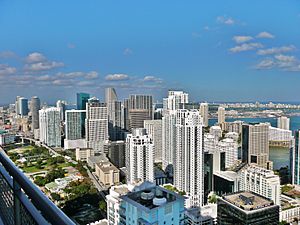
| GDP (billion US$) |
|
|---|---|
| Miami-Dade County | 219.746 |
| Broward County | 146.735 |
| Palm Beach County | 117.543 |
| Miami-Fort Lauderdale-West Palm Beach, FL (MSA) | 483.755 |
Among those employed in the Miami metropolitan area, 32% were management, professional, and related occupations, 30% were sales and office occupations, 18% were service occupations, 11% were construction, extraction, maintenance and repair occupations, and 9% were production, transportation, and material moving occupations. 81% of the people employed were Private wage and salary workers; 12% were Federal, state, or local government workers; and 7% were self-employed.
The median income of households in the Miami area was $43,091. 78% of the households received earnings and 13% received retirement income other than Social Security. 30% of the households received Social Security. The average income from Social Security was $13. These income sources are not mutually exclusive; that is, some households received income from more than one source.
In 2005, for the employed population 16 years and older, the leading industries in the Miami area were educational services, health care, and social assistance, which accounted for 18%, and Professional, scientific, and management, and administrative and waste management services, which accounted for 13% of the population. 79% of Miami area workers drove to work alone in 2005, 10% carpooled, 4% took public transportation, and 4% used other means. The remaining 3% worked at home. Among those who commuted to work, it took them on average 28.5 minutes to get to work.
Culture
Miami dialect
In Miami-Dade County a unique dialect, commonly called the Miami dialect, is widely spoken. The dialect developed among second- or third-generation Hispanics, including Cuban-Americans, whose first language was English, though some non-Hispanic white, black, and other races who were born and raised in Miami-Dade tend to adopt it as well. It is based on a fairly standard American accent but with some changes very similar to dialects in the Mid-Atlantic, especially the New York area dialect, Northern New Jersey English, and New York Latino English. Unlike Virginia Piedmont, Coastal Southern American, and Northeast American dialects and Florida Cracker dialect of the Miami accent is rhotic; it also incorporates a rhythm and pronunciation heavily influenced by Spanish in which rhythm is syllable-timed.
It is possible to differentiate the Miami accent from a variety of interlanguages spoken by second-language speakers. The Miami accent does not generally display addition of /ɛ/ before initial consonant clusters with /s/, speakers do not confuse of /dʒ/ with /j/, (e.g., Yale with jail), and /r/ and /rr/ are pronounced as alveolar approximant [ɹ] instead of alveolar tap [ɾ] or alveolar trill [r] in Spanish.
The Miami accent is much less common in Broward County and Palm Beach County, where the majority of the population is non-Hispanic.
Area codes
- 305: Miami-Dade County and the Florida Keys; overlaid by 786
- 786: Miami-Dade County and the Florida Keys; overlays 305
- 954: All of Broward County: Fort Lauderdale, Hollywood, Coral Springs, Pompano Beach, overlaid by 754
- 754: All of Broward County: Fort Lauderdale, Hollywood, Coral Springs, Pompano Beach, overlays with 954
- 561: All of Palm Beach County: West Palm Beach, Boca Raton, Boynton Beach, Delray Beach, will be overlaid by 728
- 728: All of Palm Beach County: West Palm Beach, Boca Raton, Boynton Beach, Delray Beach, will overlay with 561
Media
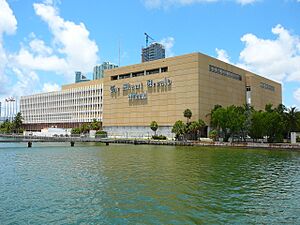
Greater Miami is served by several English-language and two major Spanish-language daily newspapers. The Miami Herald, headquartered in Doral, is Miami's primary newspaper with over a million readers. It also has news bureaus in Broward County, Monroe County, and Nassau, Bahamas. The South Florida Sun-Sentinel circulates primarily in Broward and southern Palm Beach counties and also has a news bureau in Havana, Cuba. The Palm Beach Post serves mainly Palm Beach County, especially the central and northern regions, and the Treasure Coast. The Boca Raton News publishes five days a week and circulates in southern Palm Beach County. El Nuevo Herald, a subsidiary of the Miami Herald, and Diario Las Americas, are Spanish-language daily papers that circulate mainly in Miami-Dade County. La Palma and El Sentinel are weekly Spanish newspapers published by the Palm Beach Post and Sun-Sentinel, respectively, and circulate in the same areas as their English-language counterparts.
There are several university student-run newspapers in the area, including The Miami Hurricane at the University of Miami, University Press at Florida Atlantic University, PantherNOW at Florida International University, and The Current at Nova Southeastern University.
Greater Miami is split into two separate television/radio markets: The Miami-Fort Lauderdale market serves Miami-Dade, Broward and the Florida Keys. The West Palm Beach market serves Palm Beach County and the Treasure Coast region.
Miami-Fort Lauderdale is the 12th largest radio market and the 16th-largest television market in the U.S. television stations serving the Miami-Fort Lauderdale area include WAMI-TV (UniMas), WBFS-TV (MyNetworkTV), WSFL-TV (The CW), WFOR-TV (CBS), WHFT-TV (TBN), WLTV (Univision), WPLG (ABC), WPXM (ION), WSCV (Telemundo), WSVN (FOX), WTVJ (NBC), WLRN-TV (PBS), and WPBT (also PBS), the latter television station being the only channel to serve the entire metropolitan area.
In addition to the Miami-Fort Lauderdale market, West Palm Beach has its own. It is the 49th largest radio market and the 38th-largest television market in the U.S. Television stations serving the West Palm Beach area include WPTV (NBC), WPEC (CBS), WPBF (ABC), WFLX (FOX), WTVX (The CW), WXEL (PBS), WTCN (MyNetworkTV), and WPXP (ION). The West Palm Beach market shares use of WSCV and WLTV for Telemundo and Univision respectively. Also, both markets cross over and tend to be available interchangeably between both areas. In 2015, WPBT and WXEL merged their operations, to form South Florida PBS, although both stations have maintained separate programming schedules and social media platforms, but share the same subchannel lineup.
Education
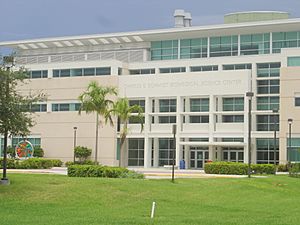
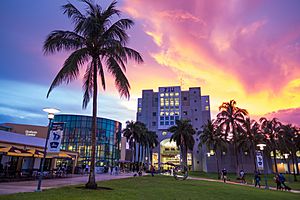

In Florida, each county is also a school district. Each district is headed by an elected school board. A professional superintendent manages the day-to-day operations of each district, who is appointed by and serves at the pleasure of the school board.
The Miami-Dade County Public School District is currently the 4th-largest public school district in the nation. The School District of Palm Beach County is the 4th-largest in Florida and the 11th-largest in the United States. Broward County Public School District is the 6th-largest in the United States.
The University of Miami is one of the top-ranked private research institutions in the United States, and has the most selective admissions standards of Florida's 171 colleges and universities.
As of 2023[update], Florida International University, with over 55,000 enrolled students, is the eighth-largest public university by enrollment in the nation.
Some colleges and universities in Greater Miami include:
- Barry University (private/Catholic)
- Broward College (public)
- Carlos Albizu University (private)
- Chamberlain University (private)
- Florida Atlantic University (public)
- Florida International University (public)
- Florida Memorial University (private/Baptist)
- Florida National University (private)
- Jersey College (private)
- Keiser University (private)
- Lynn University (private)
- Miami Dade College (public)
- Miami International University of Art & Design (private)
- Nova Southeastern University (private)
- Palm Beach Atlantic University (private/Christian)
- Palm Beach State College (public)
- St. Thomas University (private/Catholic)
- University of Fort Lauderdale (private/Christian)
- University of Miami (private)
In 2005, 82% of people 25 years and over had at least graduated from high school and 28% had a bachelor's degree or higher. Among people 16 to 19 years old, 7% were dropouts; they were not enrolled in school and had not graduated from high school. The total school enrollment in the Miami metro area was 1.4 million in 2005. Nursery school and kindergarten enrollment was 170,000 and elementary or high school enrollment was 879,000. College or graduate school enrollment was 354,000.
Transportation
Roads
The Miami metropolitan area is served by five interstate highways operated by the Florida Department of Transportation (FDOT) in conjunction with local agencies. Interstate 95 (I-95) runs north to south along the coast, ending just south of Downtown Miami at South Dixie Highway (US 1). I-75 runs east to west, turning south in western Broward County and connecting suburban north Miami-Dade to Naples on the Southwest Coast via Alligator Alley, which transverses the Florida Everglades before turning north. I-595 connects the Broward coast and Downtown Fort Lauderdale to I-75 and Alligator Alley. In Miami, I-195 and I-395 relay the main I-95 route east to Biscayne Boulevard (US 1) and Miami Beach across Biscayne Bay via the Julia Tuttle and MacArthur causeways.
In greater Miami, the Miami-Dade Expressway Authority and Florida's Turnpike Enterprise (FTE) maintain eight state expressways in conjunction with FDOT. The Airport Expressway (SR 112) and the Dolphin Expressway (SR 836) relay western Miami-Dade suburbs to the eastern urban coast at I-95, and to Miami Beach via I-195 and I-395 at the Airport and Midtown interchanges. The Gratigny Parkway (SR 924) connects northern Miami suburbs to the southern end of I-75. The Palmetto Expressway (SR 826) is the primary beltway road of urban Miami, relaying I-95 and Florida's Turnpike (SR 91) at the Golden Glades Interchange near northeastern North Miami Beach to the southern inland suburbs of Kendall and Pinecrest. The Don Shula Expressway (SR 874) and the Homestead Extension of Florida's Turnpike (SR 821) form the southernmost end of the beltway, connecting the Palmetto Expressway to the bedroom communities of Homestead and Florida City. The Snapper Creek Expressway (SR 878) relays the Don Shula Expressway to South Dixie Highway (US 1).
The urban bypass expressway in greater Fort Lauderdale is the Sawgrass Expressway (SR 869), connecting the northern Broward County coast at I-95 and Deerfield Beach to I-595 and I-75 at Alligator Alley in Sunrise.
Express lanes on I-95 start in Miami-Dade County and continue into Broward County. With an increased presence of traffic in South Florida, express lanes have been implemented in southern Palm Beach County.
Major freeways and tollways
 Interstate 95
Interstate 95 Interstate 75
Interstate 75 Interstate 195 /
Interstate 195 /  State Road 112 (Airport Expressway)
State Road 112 (Airport Expressway) Interstate 395 /
Interstate 395 /  State Road 836 (Dolphin Expressway)
State Road 836 (Dolphin Expressway) Interstate 595 (Port Everglades Expressway)
Interstate 595 (Port Everglades Expressway) Florida's Turnpike, including Homestead Extension
Florida's Turnpike, including Homestead Extension State Road 924 (Gratigny Parkway)
State Road 924 (Gratigny Parkway) State Road 874 (Don Shula Expressway)
State Road 874 (Don Shula Expressway) State Road 878 (Snapper Creek Expressway)
State Road 878 (Snapper Creek Expressway) State Road 869 (Sawgrass Expressway)
State Road 869 (Sawgrass Expressway) State Road 826 (Palmetto Expressway)
State Road 826 (Palmetto Expressway)
Major airports
The metropolitan area is served by three major commercial airports. These airports combine to make the fourth largest domestic origin and destination market in the United States, after New York City, Los Angeles, and Chicago.
| Airport | IATA code | County | FAA Category |
|---|---|---|---|
| Miami International Airport | MIA | Miami-Dade | Large Hub |
| Fort Lauderdale–Hollywood International Airport | FLL | Broward | Large Hub |
| Palm Beach International Airport | PBI | Palm Beach | Medium Hub |
The following smaller general aviation airports are also in the metro area:
| Airport | IATA code | ICAO code | County |
|---|---|---|---|
| Dade-Collier Training and Transition Airport | TNT | KTNT | Miami-Dade |
| Miami Homestead General Aviation Airport | Miami-Dade | ||
| Homestead Joint Air Reserve Base | HST | KHST | Miami-Dade |
| Miami Executive Airport | TMB | KTMB | Miami-Dade |
| Miami-Opa Locka Executive Airport | OPF | KOPF | Miami-Dade |
| Fort Lauderdale Executive Airport | FXE | KFXE | Broward |
| North Perry Airport | HWO | KHWO | Broward |
| Pompano Beach Airpark | PPM | KPMP | Broward |
| North Palm Beach County General Aviation Airport | Palm Beach | ||
| Palm Beach County Park Airport | LNA | KLNA | Palm Beach |
| Boca Raton Airport | BCT | KBCT | Palm Beach |
Seaports

The metropolis also has four seaports, the largest and most important being the Port of Miami. Others in the area include Port Everglades, Port of Palm Beach and the Miami River Port. On August 21, 2012, PortMiami and the U.S. Army Corps of Engineers signed the Partnership Agreement (PPA) construction agreement that will allow the Deep Dredge project to go out for bid. The Deep Dredge will deepen the Port's existing channels to minus 50/52 feet to prepare for the Panama Canal expansion, now scheduled for completion in early 2015. PortMiami's deeper channel will provide ships with an economically efficient, reliable and safe navigational route into the Port. PortMiami will be the only U.S. Port south of Norfolk, Virginia to be at the minus 50 foot depth in sync with the opening of the expanded Canal. Deep Dredge is expected to create more than 30,000 direct, indirect, and induced jobs in Florida and allow the Port to meet its goal to double its cargo traffic over the next decade.
Public transportation
Miami-Dade Transit (MDT) is the largest public transit agency in Florida, operating rapid transit, people movers, and an intercity bus system. Metrorail is Florida's only rapid transit, currently with 23 stations on a 24.4-mile (39.3 km) track. The Downtown Miami people mover, Metromover, operates 20 stations and three lines on a 4.4-mile (7.1 km) track through the Downtown neighborhoods of the Arts & Entertainment District, the Central Business District, and Brickell. Metrobus serves the entirety of Miami-Dade County, also serving Monroe County as far south as Marathon, and Broward County as far north as Downtown Fort Lauderdale. In Broward County, Broward County Transit runs public buses, as does Palm Tran in Palm Beach County. Additionally, the South Florida Regional Transportation Authority operates Tri-Rail, a commuter rail train that connects the three of the primary cities of South Florida (Miami, Fort Lauderdale, and West Palm Beach), and most intermediate points. Brightline provides service to Miami, Aventura, West Palm Beach, Fort Lauderdale, Boca Raton, and Central Florida's Orlando, with talks to expand to Tampa and Jacksonville.
Sports
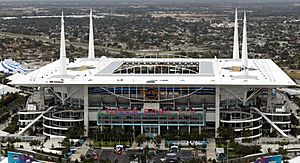
Professional
The Miami metro area is home to five major league professional sports teams.
| Professional team | League | Sport | Venue | City | Established | Championships |
|---|---|---|---|---|---|---|
| Miami Dolphins | National Football League (NFL) | Football | Hard Rock Stadium | Miami Gardens | 1966 | 2 |
| Inter Miami CF | Major League Soccer (MLS) | Soccer | Chase Stadium | Fort Lauderdale | 2020 | 1 |
| Miami Heat | National Basketball Association (NBA) | Basketball | Miami-Dade Arena | Downtown Miami | 1988 | 3 |
| Miami Marlins | Major League Baseball (MLB) | Baseball | Marlins Park | Little Havana | 1993 | 2 |
| Florida Panthers | National Hockey League (NHL) | Hockey | Amerant Bank Arena | Sunrise | 1993 | 1 |
College sports
The most prominent college sports program in the Miami metropolitan area are the Miami Hurricanes of the University of Miami in Coral Gables, who compete in Division I of the National Collegiate Athletic Association, the highest level of collegiate athletics. The University of Miami's football team has won five national championships since 1983 and its baseball team has won four national championships since 1982.
Other collegiate sports programs in the metropolitan area include the Florida Atlantic Owls of Florida Atlantic University in Boca Raton, the FIU Panthers of Florida International University in University Park, the Nova Southeastern Sharks of Nova Southeastern University in Davie, and the Barry Buccaneers of Barry University in Miami Shores.
Minor league and other sports
The Miami area is also host to minor league sports teams, including:
- The Miami Marlins and St. Louis Cardinals conduct spring training in Jupiter at Roger Dean Stadium.
- The Houston Astros and Washington Nationals conduct spring training in West Palm Beach at The Ballpark of the Palm Beaches.
- Inter Miami CF will have a reserve team that will play in USL League One.
- The Homestead-Miami Speedway oval has hosted NASCAR Cup Series and IndyCar Series events. Temporary street circuits at Museum Park hosted several CART, IMSA GT, and American Le Mans Series races between from 1986 to 1995, as well as a Formula E race in 2015. The Palm Beach International Raceway is a minor road course.
| Club | Sport | League | Venue (Capacity) | Attendance | League Championships |
|---|---|---|---|---|---|
| Miami Dolphins | Football | National Football League | Hard Rock Stadium (64,767) | 70,035 | Super Bowl (2) — 1972, 1973 |
| Miami Heat | Basketball | National Basketball Association | Kaseya Center (19,600) | 19,710 | NBA Finals (3) — 2006, 2012, 2013 |
| Miami Marlins | Baseball | Major League Baseball | LoanDepot Park (36,742) | 21,386 | World Series (2) — 1997, 2003 |
| Inter Miami CF | Soccer | Major League Soccer | Chase Stadium | 21,550 | |
| Florida Panthers | Hockey | National Hockey League | FLA Live Arena (19,250) | 10,250 | Stanley Cup (1) — 2024 |
| Miami Hurricanes | Football | NCAA D-I (ACC) | Hard Rock Stadium (64,767) | 53,837 | National titles (5) — 1983, 1987, 1989, 1991, 2001 |
| Florida Atlantic Owls | Football | NCAA D-1 (AAC) | FAU Stadium (29,571) | 18,948 | None |
| FIU Panthers | Football | NCAA D-I (Conference USA) | FIU Stadium (23,500) | 15,453 | None |
-
DRV PNK Stadium, home stadium of Inter Miami of the MLS
-
Kaseya Center, home of the Miami Heat of the NBA
-
LoanDepot Park, home of the Miami Marlins of the MLB
-
FLA Live Arena, home of the Florida Panthers
See also
 In Spanish: Área metropolitana del Sur de la Florida para niños
In Spanish: Área metropolitana del Sur de la Florida para niños


